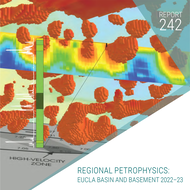Petrophysical data from stratigraphic diamond core through the Eucla Basin and Basement 2022–23
| Date: | Monday, 29 April 2024 |
|---|
A new technical report with accompanying petrophysical data has been released for 10 publicly available diamond drillholes intersecting the Eucla Basin and Basement. Eight of these drillholes (prefixed in Figure 1 of the report as MAD or FOR) were drilled by the Geological Survey of Western Australia (GSWA) in 2013 and 2014 to target distinct geophysical domains interpreted from magnetic and gravity datasets. Two additional drillholes were drilled by Exploration Incentive Scheme (EIS) co-funded company drillcore HDDH002 and company donated drillcore HANNAH 1 to target magnetic anomaly highs and included for petrophysical analysis.
Report 242, authored by Terra Petrophysics, contains a datasheet on 484 petrophysical samples taken down the length of core. The report contains a photo of each sample, a description of the methods for acquiring an array of different physical property values, and data presented in the form of petrophysical cross plots discriminated by lithology. The petrophysical data are further presented in cross plots discriminated by stratigraphic formation in Figure 2 of the report. Report 242 includes the 2020-21 petrophysical data collected on 2 Eucla drillcores reported on in Report 218.
The Geological Survey of Western Australia has a five-year program to collect petrophysical data from EIS co-funded drillcore, GSWA stratigraphic drillcore or from company-held core on request from GSWA. The current program commenced in 2021. Terra Petrophysics was awarded the tender for the data acquisition, and the project is funded by the EIS. Core selection for petrophysics is primarily chosen where data can assist in:
- modelling of geophysical data in regions with cover;
- interpretation of recent or upcoming 2D seismic lines; and
- classification of regional stratigraphy (often in conjunction with geochemistry).
How to access
Report 242 Regional petrophysics: Eucla Basin and Basement 2022-23 by Mortimore, C, Bourne, B is available from the eBookshop.
All datasets relating to Report 242 are also available under MAGIX registration number 72466. All cores sampled for petrophysics have HyLogger data and most have open-file company assay data, available from the Mineral Exploration Reports Database (WAMEX).
For more information, contact GSWA Project Manager Sasha Banaszczyk.
Figure 1. Drillcore locations sampled for petrophysics: a) statewide drillcores sampled since 2021, shown on tectonic units map (2021) with major crustal boundaries; b) location of 10 drillholes sampled for petrophysics (this report) shown on 400 m gravity data (colour) draped over an 80 m 1VD total magnetic intensity data grid (grey scale).
Figure 2. Petrophysical cross plots coloured by stratigraphic formation: a) galvanic resistivity against magnetic susceptibility; b) dry bulk density against magnetic susceptibility; c) galvanic resistivity against chargeability; d) dry bulk density against p-wave velocity for 10 drillholes from the Eucla Basin and Basement.

